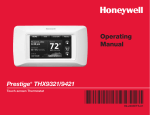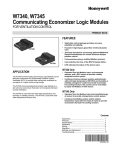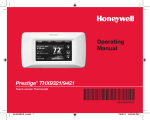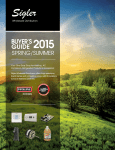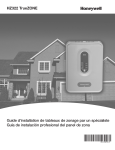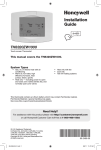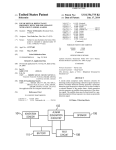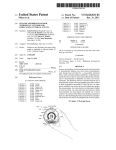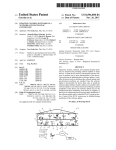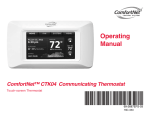Download Honeywell PRESTIGE THX9421 User's Manual
Transcript
System Installation Guide THX9321/9421 Prestige IAQ and RF EIM ® With wireless accessories Control for up to 4 Heat/2 Cool heat pump systems or up to 3 Heat/2 Cool conventional systems for residential and commercial applications. Installation guide for: • Prestige THX9321/9421 thermostat • Wireless Outdoor Sensor • Equipment Interface Module (EIM) • Wireless Indoor Sensor • Portable Comfort Control • RedLINK Internet Gateway ™ Quick start guide 1 Install thermostat...........................................................page 3 2 Install optional Equipment Interface Module (EIM)................. 3 3 Power optional accessories.................................................... 4 4 Link thermostat to wireless network....................................... 5 5 Link optional accessories to wireless network....................... 6 6 Install optional sensors........................................................... 7 7 Customize thermostat (installer options)................................ 8 Wiring guides...................................................................10-17 Key features.....................................................................18-25 Device replacement and specifications...........................26-27 DISCONNECT POWER BEFORE INSTALLATION. Can cause electrical shock or equipment damage. MERCURY NOTICE: If this product is replacing a control that contains mercury in a sealed tube, do not place the old control in the trash. Contact the Thermostat Recycling Corporation at www.thermostat-recycle.org or 800-238-8192 for information on how and where to properly and safely dispose of your old thermostat. Must be installed by a trained, experienced technician. Read these instructions carefully. Failure to follow these instructions can damage the product or cause a hazardous condition. ® U.S. Registered Trademark. Copyright © 2011 Honeywell International Inc. All rights reserved. 69-2490_B.indd 1 69-2490-03 7/13/2011 1:41:45 PM System Installation Guide Your Honeywell advantage RedLINK™ Compatible Increase your content and profit per job by including RedLINK™ accessories that meet your customers comfort and convenience needs. RedLINK accessories include the Wireless Outdoor Sensor, Portable Comfort Control (PCC), Equipment Interface Module (EIM), RedLINK Internet Gateway, Wireless Indoor Sensor, TrueSTEAM™ humidifier with Wireless Adapter, TrueZONE™ zoning panel with Wireless Adapter, Vent Boost Remote and Wireless Remote. Customizable Service Reminders Set up to 10 service reminders. Choose from the pre-set options or customize your own. Reminders based on date, outdoor temperature or a dry contact input will alert customers with instructions to contact you for assistance. Delta T Alerts and Diagnostics Alerts give customers a sense of security while also enabling you to service or replace the equipment prior to a loss of heating or cooling. Based on limits you set at installation, customers can be alerted when their system is not operating as expected. The system alert will instruct customers to contact you for assistance. Requires EIM. Delta T Installer Test Save time by viewing Delta T while running a system test to verify proper operation. Requires EIM. Universal Inputs – S1 and S2 Assignable inputs allow you to configure Indoor and Outdoor Temperature Sensors, Discharge and Return Air Sensors or Dry Contact Devices. Dry Contact Devices can be used to trip pre-set or customized alerts on the thermostat home screen. Requires EIM. User Interaction Log The interaction log stores history of thermostat setting changes including temperature, system and installer setup. You can use the interaction log to save time by determining if the issue is a system error or an accidental user error. Configurable for Residential and Light Commercial Applications One thermostat does it all to meet the needs of Residential and Light Commercial applications. Simply select Residential or Commercial during the installer setup. If Commercial is selected, the thermostat will use commercial language, meet building codes and offer 365 day holiday scheduling. USB Port for Quick Installer Setup Save time by using a USB stick to upload installer settings and service reminders in one simple step. Equipment Setup Wizard The thermostat installer uses plain language and simple questions to guide you through the set-up process. Settings are automatically modified according to the type of equipment selected, helping to eliminate common installation errors. Selectable Sensors When paired with a Wireless Indoor Sensor(s) you have the ability to choose which sensor(s) to use for temperature, humidification and dehumidification. They can be used in combination for temperature averaging—or individually—to condition humidity levels in separate spaces. 69-2490—03 69-2490_B.indd 2 2 7/13/2011 1:41:45 PM THX9321/9421 Prestige IAQ and RF EIM ® 1 Install thermostat MCR29241 MCR32386 MCR32387 • THX9421: Mount the thermostat and wire to C and R terminals of the Equipment Interface Module (EIM), or to a separate 24 volt transformer (not provided). • THX9321: Install and wire as above if using EIM. If not, see pages 13-15. When used with the EIM, the relays in the thermostat do not function. See pages 10-17 for detailed wiring guidelines 2 Install Equipment Interface Module (if used) [If no EIM is used, skip to Section 3.] Use screws & anchors as appropriate for the mounting surface. Mount the EIM near the HVAC equipment, or on the equipment itself. Strip 1/4” insulation, then insert wires as shown. R W3 W2 W AUX2AUX1 O/B C Y Y2 G L MCR32389 MCR32388 If installing a discharge/return air sensor, it must be located between the IAQ equipment and the heating/cooling equipment. The sensors must be in air that is mixed well (away from a-coil/heat exchanger). See page 7. NOTE: If you install more than one thermostat and EIM, the EIMs must be at least 2 feet apart. 3 69-2490_B.indd 3 69-2490—03 7/13/2011 1:41:48 PM System Installation Guide 3 Power optional accessories [If no wireless accessories are used, skip to Section 4.] Outdoor air sensor Indoor air sensor MCR32938 MCR32937 Install 2 fresh AA lithium batteries Install 2 fresh AAA alkaline batteries Portable Comfort Control MCR32939 Install 3 fresh AA alkaline batteries RedLINK™ Internet Gateway The Honeywell RedLINK Internet Gateway gives your customers remote access to home climate-control systems from any location with Internet access. Using a Web browser, users can review and adjust indoor temperature, system mode and other settings. The Gateway can also send alerts to as many as 6 email addresses if a problem occurs. Connect power cord to an electrical outlet not controlled by a wall switch Connect RedLINK Gateway to a router or modem with Ethernet cable (RJ45). M32940 69-2490—03 69-2490_B.indd 4 4 7/13/2011 1:41:49 PM THX9321/9421 Prestige IAQ and RF EIM ® 4 Link thermostat to the wireless network (if used with an EIM or TrueZONE Wireless Adapter) Next, link all components and RedLINK accessories to the wireless network. ™ Initial powerup configuration When the thermostat is first activated, it will lead you through the steps necessary to define and set up your system. The steps will change depending on the type of system and thermostat you're installing. Setup options for THX9321 Setup options for THX9421 If non-zoned system: • Setup for thermostat only • Setup for use with EIM If non-zoned system: • Setup for EIM connection If zoned system: • Setup for EIM wired to zone panel • Setup for RedLINK wireless connection to zone panel (using THM4000 TrueZONE Wireless Adapter) If zoned system: • Setup for EIM wired to zone panel • Setup for thermostat wired to zone panel • Setup for RedLINK wireless connection to zone panel (using THM4000 TrueZONE Wireless Adapter) Link thermostat to EIM or TrueZONE Wireless Adapter ® Use the step-by-step thermostat menus to define your system type (above). When you reach the Wireless Setup screen, follow the steps below: Press and release the CONNECT button at the EIM or Wireless Adapter, and make sure the "Connected" light is flashing green. CONNEC CONNEC TED T S2 S2 S1 S1 If the "Connected" light does not flash, make sure no other RedLINK devices are in Wireless Setup mode, then try again. If the "Connected" light does not flash on the Wireless Adapter, consult the TrueZONE manual for help. MCR32941 "Connected" status light • Green flashing: In Wireless Setup mode. • Green steady: System is working normally. • Red: Wireless device(s) not communicating. Check EIM and RedLINK devices. While the EIM light is flashing, press NEXT to link the thermostat with the EIM. After a brief delay, the screen will display "Device Connected." At any screen you can press HELP for more information, or press BACK to change earlier options. 5 69-2490_B.indd 5 69-2490—03 7/13/2011 1:41:50 PM System Installation Guide 5 Link optional accessories to wireless network While the Add Device screen is displayed on the thermostat, press and release the CONNECT button on each wireless device, as described below. Accessories need to be at least 2 feet away from the thermostat or EIM during the linking process. Press DONE after all devices have been linked Wireless outdoor sensor Wireless indoor sensor MCR32934 MCR32935 MCR28847A Press and release CONNECT. After a short delay the thermostat will display outdoor temperature and humidity. Press and release CONNECT. After a short delay, the status light will glow green for 15 seconds. If the status light turns red, the sensor did not link with the thermostat. In normal operation, this light remains off. If it begins flashing red, batteries are low (power will be depleted after 3 weeks). Portable Comfort Control Press CONNECT on the Portable Comfort Control display screen. Press DONE when the screen displays "Connected," then exit or continue to link another thermostat. CONNECT WIRELESS SETUP Error messages: E1 29 Incompatible device cannot be connected. E1 34 Low RF signal. Move device to a different location and try again. E1 38 Make sure the thermostat or the EIM is in Wireless Setup mode, and the Portable Comfort Control is at least 2 feet away (600 mm). MCR32942 The linking procedure will time out if there is no keypress for 30 minutes. To begin again, press and hold the blank space in the lower right corner of the screen (an arrow may appear here). Hold until the display changes (about 3 seconds). RedLINK Internet Gateway Press and release the button on the bottom of the Internet Gateway. After a short delay, the RedLINK status light will glow steady green. MCR32943 69-2490—03 69-2490_B.indd 6 The Internet Gateway must be registered online before use at www.mytotalconnectcomfort.com. Enter the MAC ID and MAC CRC numbers located on the bottom of the Internet Gateway. For additional information, see instructions provided with the device. 6 7/13/2011 1:41:51 PM THX9321/9421 Prestige IAQ and RF EIM ® 6 Install optional sensors [If no sensors are used, skip to Section 7.] To install outdoor air sensor 1 Mount the sensor on a vertical exterior wall, at least 6 inches below any overhang. Choose a location protected from direct sunlight. 2 Place sensor securely in bracket, facing away from wall. M28491 M28849A To install indoor air sensor 1 Remove the wallplate and mount it 4 to 6 feet above the floor on an interior wall. Drill 3/16-inch holes for drywall, 7/32-inch for plaster. 2 Attach sensor securely to wallplate as shown. M32936 To install discharge/return air sensor 1 Install the sensor between the IAQ equipment and the heating/cooling equipment. The sensors must be in air that is mixed well (away from a-coil/ heat exchanger). M32995 2 Drill 1/4-inch hole for the sensor probe and mount it to the ductwork with enclosed screws. 3 Connect wires to S1 or S2 terminals at the EIM. 7 69-2490_B.indd 7 69-2490—03 7/13/2011 1:41:52 PM System Installation Guide 7 Setup Installer options (ISU) To configure the thermostat, press MENU > INSTALLER OPTIONS, then enter date code when prompted (printed on back of thermostat). Or press MENU > EQUIPMENT STATUS to find the date code. A brief summary of installer options follows. You can download a complete list of all options at http://customer.honeywell.com. Press CREATE SETUP to set all system settings one by one. Press VIEW/EDIT to select a specific function and make quick changes. TIP: You can use the thermostat USB port to download all system configuration and installer options, including your company name and contact information. You can upload this data to each thermostat you install, to save time. R: Residential C: Commercial B: Both ISU Function 1000Language 1010Residential/Commercial 1020 Zone Number 1030 Device Name 1030 Device Name on Home Screen 1040Programmable/Non-programmable 1050Fahrenheit/Celsius 1060 Outdoor Air Sensor 2000 Heating System Type 2010 Heating Equipment Type 2020-2100 Heat Stages 2050 Geothermal Forced Air System 2060 Reversing Valve O/B 2070-2090 Cool/Compressor Stages 2110 Fan Operation in Heat 2120, 2180 Backup Heat Type 2130, 2170 Backup Heat Stages 2150, 2200 Backup Heat Operation 2160, 2210 Backup Heat Fan Operation 2190 External Fossil Fuel Kit 2220 L/A Terminal Setup 3000 Manual/Auto Changeover 3000 Auto Changeover Deadband 3010 Temperature Control Options 3020 Finish With High Cool Stage 3021 Finish With High Heat Stage 3030 Staging Control - Cool Differentials 3040-3060 Staging Control - Heat Differentials 3070 Balance Point Only or Differential 3080, 3090 Staging Control - Backup Heat Differentials 3110 Backup Heat Upstage Timer 3120 Outdoor Compressor Lockout 3120 Outdoor Backup Heat Lockout 3130, 3150 Heat Cycles Per Hour 3140 Cool Cycles Per Hour 3160 Backup Heat Cycles Per Hour 69-2490—03 69-2490_B.indd 8 Thermostat functions marked in gray below require an EIM (see page 3). B B B B C B B B B B B B B B B B B B B B C B B B B B B B B B B B B B B B ISU Function 3170-3190 3200-3220 3240 3260 3260 4000 4010 4020 4030 4050 4060 4070 4080 4090 4100 4100 4110 4120 Cooling Derivative, Integral, Throttling range Heating Derivative, Integral, Throttling range Minimum Compressor Off Time Extended Fan Run Time in Cool Extended Fan Run Time in Heat Number of Scheduled Periods Pre-occupancy Purge Duration Override: Standard or Initiate Occupancy Override Duration Minimum Recovery Settings - Heat Maximum Recovery Settings - Heat Minimum Recovery Settings - Cool Maximum Recovery Settings - Cool Adaptive Intelligent Recovery Minimum Cool Setpoint Maximum Heat Setpoint Keypad Lockout Wireless Remote* Home/Occupied Cool Setpoint Wireless Remote* Home/Occupied Heat Setpoint Wireless Remote* Away/Unoccupied Cool Setpoint Wireless Remote* Away/Unoccupied Heat Setpoint Wireless Remote* Vacation/Holiday Cool Setpoint Wireless Remote* Vacation/Holiday Heat Setpoint Select Wired Sensors Indoor Temperature Sensor Name Terminals Wired to Indoor Sensor Indoor Temperature Sensor Type Indoor Sensors Used for Temperature Control Terminals Wired to Outdoor Sensor Terminals Wired to Return Air Sensor 4120 4130 4130 4140 4140 5000 5010 5020 5030 5040 5050 5070 C C B B B B C C C C C C C R B B B B B B B B B B B B B B B B 8 * Wireless Remote - coming soon. 7/13/2011 1:41:52 PM THX9321/9421 Prestige IAQ and RF EIM ® 7 Installer options (ISU) Thermostat functions marked in gray below require an EIM (see page 3). ISU Function ISU 5080 5090 5100 5110 6000 6010 6020 6030 6040 6040 6050 Return Air Sensor Type B Terminals Wired to Discharge Air Sensor B Discharge Air Sensor Type B A-Coil Low Temperature Cutoff B Select the Dry Contacts in the System B Terminals Wired to Remote Setback Dry ContactC Remote Setback Dry Contact Setup C Remote Setback Time Delay C Remote Setback - Standby Cool Setpoint C Remote Setback - Standby Heat Setpoint C Terminals Wired to Full Drain Pan Alert Dry Contact B 6060 Full Drain Pan Alert Dry Contact Setup B 6070 Terminals Wired to Dirty Filter Alert Dry ContactB 6080 Dirty Filter Alert Dry Contact Setup B 6090 Terminals Wired to Water Leak Alert Dry ContactB 6100 Water Leak Alert Dry Contact Setup B 6110 Terminals Wired to System Shutdown Alert Dry Contact C 6120 System Shutdown Alert Dry Contact Setup C 6130 Terminals Wired to Service Needed Alert Dry Contact B 6140 Service Needed Alert Dry Contact Setup B 6150 Terminals Wired to Fan Failure Alert Dry ContactC 6160 Fan Failure Alert Dry Contact Setup C 6170 Terminals Wired to Custom Alert Dry Contact B 6180 Custom Alert Dry Contact Setup B 6190, 6200 Custom Alert Name and Message B 7000 Filter Type B 7020 Number of Air Filters B 7110 Air Filter Replacement Reminder B 7110 Air Filter 2 Replacement Reminder B 7120 EAC Cell Cleaning Reminder B 7120 EAC Pre-Filter Cleaning Reminder B 7120 EAC Post-Filter Replacement Reminder B 8000 Humidifier Type B 8010 Indoor Sensor Used for Humidification Control B 8030 Terminals Wired to the Humidifier B 8050 Humidification - Window Protection B 8060 System Modes Allowing Humidification B 8070 Humidification Control B 8080 Humidifier Lockout B 8100 Clean Tank / Water Filter Replacement ReminderB 8100 Humidifier Pad Replacement Reminder B 9000 Dehumidification Equipment B 9010 Indoor Sensor Used for Dehumidification Control B 9020 Humidity Sensor Displayed on the Home Screen B 9040 Terminals Wired to Dehumidification Equipment B 9050 A/C with Low Speed Fan Setup B 9050 Hot Gas Bypass Setup C 9070 Dehumidification - Overcooling Limit R 9080 Dehumidification Control C 9090 Dehumidification Minimum On Time C 9100 High Humidity Comfort Reset Setting C 9110 Dehumidification High Limit Range Stop C 9120 9130 9140 9180 9190 9200 System Modes Allowing Dehumidification B Dehumidifier Fan Control B Dehumidifier Lockout B Dehumidification Away Mode B Dehumidification Away Mode - Fan Control B Dehumidification Away Mode Low Limit Temperature B 9200 Dehumidification Away Mode Temperature Setting B 9200 Dehumidification Away Mode Dehumidification Setting B 9210 Dehumidifier Filter Replacement Reminder B 10000 Ventilation Type B 10020 Terminals Wired to Ventilator/Fresh Air Damper B 10050 Ventilation Control Method B 10060 Ventilation Fan Control B 10090 Number of Bedrooms R 10090 Size of House R 10100 Ventilation Level (CFM) R 10120 Ventilation Percent On Time B 10130 Ventilation Low Temperature Lockout B 10130 Ventilation High Temperature Lockout B 10130 Ventilation High Dewpoint Lockout B 10140 Lockout Ventilation on Hum/Dehum Calls B 10160 Ventilate on High Indoor Humidity B 10170 Ventilator Core Cleaning Reminder B 10170 Ventilator Filter Cleaning Reminder B 11000 Number of UV Devices B 11050 UV Bulb Replacement Reminder B 11050 UV Bulb 2 Replacement Reminder B 12000 Installer Custom Reminders B 13000 Heat Delta T Diagnostics B 13010 Cool Delta T Diagnostics B 13015 Set Advanced Delta T Diagnostic Options B 13020 Allow Delta T Diagnostics During HumidificationB 13030 Allow Delta T Diagnostics During Dehumidification B 13040 Allow Delta T Diagnostics During Ventilation B 13050-13080Allow Heat Delta T Diagnostics: Temp & Humidity B 13090-13120Allow Backup Heat Delta T Diagnostics: Temp & Humidity B 13130-13160Allow Cool Delta T Diagnostics: Temp & Humidity B 13170 Defrost Cycle B 13180 Delta T Fault Sensitivity B 13190 Display Delta T Alerts to Homeowner B 14000 Clock Format B 14010 Daylight Saving Time B 14020 Indoor Temperature Display Offset B 14020 Indoor Humidity Display Offset B 15000-15020Dealer name, phone, email, website, message B 9 69-2490_B.indd 9 Function 69-2490—03 7/13/2011 1:41:53 PM System Installation Guide EIM wiring guide — conventional systems Typical wiring of a conventional system with up to 3-stage heat and 2-stage cool with one transformer. EIM TO THERMOSTAT 24 C VAC CONV POWER HEAT COOL STATUS LEDS R FURNACE TRANSFORMER HEAT STAGE 1 W HEAT STAGE 2 W2 W3 FAN U1 U2 U3 120 VAC HEAT STAGE 3 G FAN A 4 Y COMPRESSOR STAGE 1 Y2 COMPRESSOR STAGE 2 1 JUMPERS 3 SENSORS CONNECT OPTIONAL SENSORS TO S1 AND S2 TERMINALS (MAX. 2 SENSORS) 2 1 See guides on following pages for thermostat wiring and geothermal radiant heat wiring. 2 Wire a maximum of 2 sensors using the S1 and S2 terminals. See ISU 5000-6190 for options. 3 Remove jumper(s) if using separate transformers. 4 See Economizer wiring section. MCR32945 See following pages for additional thermostat wiring guidlines for heat pumps, geothermal systems and optional Economizer. 69-2490—03 69-2490_B.indd 10 10 7/13/2011 1:41:54 PM THX9321/9421 Prestige IAQ and RF EIM ® EIM wiring guide — heat pump systems Typical wiring of a heat pump system with up to four-stage heat and two-stage cool with one transformer. EIM TO THERMOSTAT O/B HEAT PUMP O/B POWER HEAT STATUS LEDS BACKUP HEAT STAGE 1 AUX1 AUX1 COOL FAN U1 U2 U3 CHANGEOVER VALVE BACKUP HEAT STAGE 2 AUX2 AUX2 Y COMPRESSOR STAGE 1 L/A 3 1 Y2 COMPRESSOR STAGE 2 G FAN RELAY L/A COMPRESSOR MONITOR OR 3 ZONE PANEL JUMPERS R C AIR HANDLER TRANSFORMER 24 VAC 120 VAC 2 SENSORS CONNECT OPTIONAL SENSORS TO S1 AND S2 TERMINALS (MAX. 2 SENSORS) 2 MCR32946 1 See guides on following pages for thermostat wiring and geothermal radiant heat wiring. 2 Wire a maximum of 2 sensors using the S1 and S2 terminals. See ISU 5000-6190 for options. 3 L/A terminal sends continuous output when thermostat is set to EM HEAT mode, except when set up for Economizer or TOD. See Economizer wiring section. 11 69-2490_B.indd 11 69-2490—03 7/13/2011 1:41:54 PM System Installation Guide EIM wiring guide — geothermal radiant heat Typical wiring for geothermal radiant heat, geothermal forced-air, and backup heat with one transformer. EIM TO THERMOSTAT O/B HEAT PUMP STATUS LEDS O/B POWER HEAT COOL FAN U1 U2 U3 AUX1 AUX2 CHANGEOVER VALVE BACKUP HEAT STAGE 1 AUX1 BACKUP HEAT STAGE 2 AUX2 COMPRESSOR Y STAGE 1 L/A 3 COMPRESSOR Y2 STAGE 2 G FAN RELAY L COMPRESSOR MONITOR OR ZONE PANEL 3 GEOTHERMAL RADIANT HEAT STAGE 1 1 OPTIONAL JUMPER R 2 C AIR HANDLER TRANSFORMER 24 VAC 120 VAC 2 JUMPERS CONNECT OPTIONAL SENSORS TO S1 AND S2 TERMINALS SENSORS (MAX. 2 SENSORS) MCR32947 1 U1, U2 or U3 terminals must be used for geothermal radiant heat (ISU 2010). Thermostat allows 2 stages of radiant heat— geothermal (stage 1) and boiler (stage 2). 2 “U” terminals are normally open dry contacts when set up for geothermal radiant heat. You must install a field jumper if radiant heat is powered by system transformer. Do NOT install a field jumper if radiant heat has its own transformer. 3 L/A terminal sends continuous output when thermostat is set to EM HEAT mode except when set up for Economizer or TOD. See Economizer wiring section. 69-2490—03 69-2490_B.indd 12 12 7/13/2011 1:41:55 PM THX9321/9421 Prestige IAQ and RF EIM ® Thermostat wiring guides — Prestige THX9321 Typical wiring of a 3-heat / 2-cool heat pump system with one transformer Transformer 24 VAC Transformer C R HEAT STAGE 2 Y COMPRESSOR STAGE 1 U1 Y2 COMPRESSOR STAGE 2 U1 G FAN RELAY Y COMPRESSOR STAGE 1 R Y2 COMPRESSOR STAGE 2 G FAN RELAY L/A COMPRESSOR MONITOR OR ZONE PANEL 6 U2 6 MCR32948 Typical wiring of a 3-heat / 2-cool heat pump system with two transformers 24 VAC COMPRESSOR STAGE 1 Y2 COMPRESSOR STAGE 2 G L/A 6 K 1 Rc 3 U2 O/B AUX/E 120 VAC 24 VAC C BACKUP HEAT Rc Y2 COMPRESSOR STAGE 2 FAN RELAY U1 G FAN RELAY COMPRESSOR MONITOR OR ZONE PANEL U2 L/A COMPRESSOR MONITOR OR ZONE PANEL 1 U2 120 VAC 24 VAC R C 6 BACKUP HEAT K C R CHANGEOVER VALVE U1 2 U2 MCR32949 COMPRESSOR STAGE 1 R U1 1 Y Backup Heat Transformer U1 2 R 4 Thermostat C CHANGEOVER VALVE R K Transformer C R AUX/E Y Rc 5 Typical wiring for geothermal radiant heat, geothermal forced-air and backup heat with one transformer Thermostat O/B 120 VAC C A 2 Air Handler Transformer C R Thermostat HEAT STAGE 1 Rc K 24 VAC W C BACKUP HEAT 1 120 VAC W2 CHANGEOVER VALVE AUX/E Thermostat O/B 120 VAC Typical wiring of a 2-heat / 2-cool conventional system with one transformer U1 GEOTHERMAL RADIANT HEAT STAGE 1 U1 U2 3 U2 MCR32951 MCR32950 1 U1 and U2 terminals are dry contacts. 2 L/A terminal sends continuous output when thermostat is set to EM HEAT mode except when set up for Economizer or TOD. See Economizer wiring section. 3 U1 or U2 terminals must be used for geothermal radiant heat (ISU 2010). Thermostat allows 2 stages of radiant heat— geothermal (stage 1) and boiler (stage 2). 4 "U" terminals are normally open dry contacts when set up for geothermal radiant heat. You must install a field jumper if radiant heat is powered by system transformer. Do NOT install a field jumper if radiant heat has its own transformer. 5 Remove jumper if using separate transformers. 6 Connect the THP9045 Wiresaver Module to the K terminal in heating/cooling applications that do not have a common wire at the thermostat. The K terminal cannot be used in heat-only applications. See THP9045 installation instructions for more information. 13 69-2490_B.indd 13 69-2490—03 7/13/2011 1:41:56 PM System Installation Guide Prestige THX9321 or EIM: Using universal relays to control heating or cooling Powering universal relay with system transformer (THX9321 shown) Transformer 120 VAC 24 VAC Transformer C R Rc 2 R 24 VAC C R C Rc 2 1 HEAT STAGE 3 U2 U2 R U1 U1 U1 Thermostat C HEAT STAGE 3 or COOL STAGE 3 or COOL STAGE 4 120 VAC Thermostat 3 Powering universal relay with separate heating transformer (THX9321 shown) Transformer 1 120 VAC R 24 VAC C 3 1 U1 U2 1 U2 MCR32953 MCR32952 1 U1/U2/U3 terminals are normally open dry contacts when set up for a stage of heating or cooling. 2 You must install a field jumper if the stage of heating or cooling is powered by system transformer. Do NOT install a field jumper if the stage of heating has its own transformer. 3 U1/U2/U3 terminals are assigned to a stage of heating or cooling in the Installer Setup. Options are: • Heat -- Stage 3 (last stage of heating) -- ISU 2100, 2140, or 2170 • Cool: Stage 3 -- ISU 2080 • Cool: Stage 4 -- ISU 2090 • Geothermal radiant heat: Stage 1 -- (see wiring guide on pages 12-13) • Geothermal radiant heat: Stage 2 -- (see wiring guide on pages 12-13) 69-2490—03 69-2490_B.indd 14 14 7/13/2011 1:41:57 PM THX9321/9421 Prestige IAQ and RF EIM ® Wiring guide — IAQ equipment (EIM or thermostat) "U" terminals can be used for humidification, dehumidification or ventilation. With power supply Without power supply Typical hookup of powered humidifier. Typical hookup of non-powered humidifier. U3 U3 U3 U2 U3 U2 U2 U2 U1 POWERED HUMIDIFIER U1 24 VAC U1 RH FIELD INSTALLED JUMPER BETWEEN R AND U1 RH RC 24 VAC NON-POWERED HUMIDIFIER U1 120 VAC RC 24 VAC R C 120 VAC 24 VAC M32393 R 120 VAC 24 VAC C M32394 Typical hookup of powered ventilation. Typical hookup of non-powered ventilation. U3 U3 U3 U2 U3 U2 U2 U2 U1 POWERED VENTILATOR U1 24 VAC U1 RH FIELD INSTALLED JUMPER BETWEEN R AND U1 RH RC 24 VAC NON-POWERED VENTILATOR U1 120 VAC RC R 24 VAC C 120 VAC 24 VAC R 24 VAC C 120 VAC M32396 M32397 Typical hookup of powered dehumidifier (whole house dehumidifier). Typical hookup of variable speed blower for dehumidification in low speed. U3 U3 U3 U2 U3 U2 U2 U2 U1 U1 POWERED DEHUMIDIFIER U1 24 VAC 120 VAC OR RH 2 DEHUMIDIFICATION WITH LOW SPEED FAN U1 FIELD INSTALLED JUMPER BETWEEN R AND U1 RH RC 24 VAC 1 RC R 24 VAC C 120 VAC 24 VAC M32398 R C 24 VAC 120 VAC M32392 KEY 1 ANY COMBINATION OF UNIVERSAL RELAYS (U1, U2, U3) CAN BE USED. THEY ARE SET IN THE THERMOSTAT INSTALLER SETUP. 2 WIRE THE THERMOSTAT OR EIM UNIVERSAL RELAY TO THE LOW SPEED FAN FOR DEHUMIDIFICATION CONTROL AT THE EQUIPMENT. THE THERMOSTAT OR EIM RELAY CAN BE SET TO NORMALLY OPEN OR NORMALLY CLOSED IN THE THERMOSTAT INSTALLER SETUP. = NORMALLY OPEN, DRY CONTACTS = NORMALLY CLOSED, DRY CONTACTS M32954 15 69-2490_B.indd 15 69-2490—03 7/13/2011 1:41:59 PM System Installation Guide Economizer Module wiring guides Typical wiring of a W7220 Economizer Module for a heat pump system, using a Prestige THX9321 thermostat or Equipment Interface Module. Rooftop Unit O/B N Y1 Y2 AUX AUX 2 G O/B L/A Y Y2 AUX AUX 2 G W7220 Economizer Module (See wiring guidelines provided with the product) SD-O/B OCC E-GND AUX Y2I Y2O Y1I Y1O C R 1 Transformer 120 VAC R 24 VAC 2 Thermostat/EIM C MCR32959 Typical wiring of a W7220 Economizer Module for a conventional system, using a Prestige THX9321 thermostat or Equipment Interface Module. Rooftop Unit N Y1 Y2 W1 W2 G A Y Y2 W W2 G W7220 Economizer Module (See wiring guidelines provided with the product) SD-O/B OCC E-GND AUX Y2I Y2O Y1I Y1O C R 1 Transformer 120 VAC R 24 VAC C Thermostat/EIM MCR32955 1 “A” or “L/A” terminal must be configured for Economizer in the installer setup (ISU 2220). These terminals are powered by the cooling transformer (Rc terminal). 2 Terminal AUX 2 is present only on the Equipment Interface Module. 69-2490—03 69-2490_B.indd 16 16 7/13/2011 1:42:00 PM THX9321/9421 Prestige IAQ and RF EIM ® Economizer Module wiring guides Typical wiring of a W7213/W7214 Economizer Module for a heat pump system, using a Prestige THX9321 thermostat or Equipment Interface Module. Rooftop Unit O/B N Y1 Y2 AUX AUX 2 G O/B L/A Y Y2 AUX AUX 2 G W7213/W7214 Economizer Module (See wiring guidelines provided with the product) O or B N 3 4 1 2&5 TR1 TR 1 Transformer 120 VAC R 24 VAC 2 Thermostat/EIM C MCR32956 Typical wiring of a W7212 Economizer Module for a conventional heating system, using a Prestige THX9321 thermostat or Equipment Interface Module. Rooftop Unit N Y1 Y2 W1 W2 G A Y Y2 W W2 G W7212 Economizer Module (See wiring guidelines provided with the product) N 3 4 1 2&5 TR1 TR 1 Transformer 120 VAC R 24 VAC C Thermostat/EIM MCR32957 1 “A” or “L/A” terminal must be configured for Economizer in the installer setup (ISU 2220). These terminals are powered by the cooling transformer (Rc terminal). 2 Terminal AUX 2 is present only on the Equipment Interface Module. 17 69-2490_B.indd 17 69-2490—03 7/13/2011 1:42:00 PM System Installation Guide Economizer and TOD operation (ISU 2220) Commercial use only The Economizer can greatly reduce energy costs if configured properly. In some climates the cooling system may run hundreds of hours, when it may not be required to maintain indoor comfort. In some conditions, ventilation with outdoor air can achieve the same level of comfort at lower cost. Tables below explain how the Economizer feature maintains comfort while minimizing costs. Thermostat Mode Equipment Operation Occupied Heat/Cool/Fan running Occupied temporarily Heat/Cool/Fan running Occupied Heat/Cool/Fan NOT running Occupied temporarily Heat/Cool/Fan NOT running Pre-occupancy purge Fan running Unoccupied Cooling system running Unoccupied temporarily Cooling system running Standby Cooling system running Unoccupied Cooling system NOT running Unoccupied temporarily Cooling system NOT running Standby Cooling system NOT running Non-programmable Fan running Non-programmable Fan NOT running Thermostat Mode A-L/A terminal: Economizer ON OFF ON OFF A-L/A terminal: TOD Occupied ON Occupied temporarily Temperature overrides Unoccupied Unoccupied temporarily OFF Standby Non-programmable 69-2490—03 69-2490_B.indd 18 18 7/13/2011 1:42:00 PM THX9321/9421 Prestige IAQ and RF EIM ® Heat pump with outdoor temperature lockouts Outdoor temperature lockouts are optional. See Installer Setup options (ISU 3120). Outdoor temperature Backup heat allowed to run with heat pump (see table below) Heat pump only Backup heat lockout Heat pump with backup heat as needed * Compressor lockout Backup heat only * No backup heat unless indoor temperature drops to selected Backup Heat Differential setting, or Backup Heat Upstage Timer expires. Heat pump stays ON when backup heat turns on. Outdoor temperature Backup heat NOT allowed to run with heat pump (see table below) Heat pump only Backup heat lockout Heat pump or backup heat operates * Compressor lockout Backup heat only * No backup heat unless indoor temperature drops to selected Backup Heat Differential setting, or Backup Heat Upstage Timer expires. Heat pump turns OFF when backup heat turns on. Heat pump and backup heat operation Backup Heat Type Backup Heat Operation Backup Heat Fan Operation Electric forced air Allowed to run with heat pump Thermostat controls fan Gas or oil forced air NOT allowed to run with heat pump Equipment controls fan Hot water radiant heat Allowed to run with heat pump [n/a] Hot water fan coil Selectable in installer setup Thermostat controls fan Other Selectable in installer setup Selectable in installer setup 19 69-2490_B.indd 19 69-2490—03 7/13/2011 1:42:00 PM System Installation Guide Basic and Advanced Temperature Control Options (ISU 3010) Basic Options: The Installer Setup displays basic temperature control options which include Backup Heat Differential, Backup Heat Upstage Timer and Outdoor Temperature Lockouts. Note: Outdoor Temperature Lockouts only apply to Heat Pump applications. Advanced Options: The Installer Setup displays both Basic and Advanced Options. Advanced temperature control options include Finish With High Cool Stage, Finish With High Heat Stage, Temperature Differential settings per stage and Cycle Rate settings per stage. Finish With High Heat or Cool Stage - When a multi-stage heating or cooling system is used, this feature keeps the high stage of the heating or cooling equipment running until the desired setpoint is reached. Recommended setting for Geothermal Heat Pumps to allow the loop to rest. Backup heat differential and upstage timer A backup heat differential and backup heat upstage timer can be set on any system that has more than one type of heating equipment. See installer setup options (ISU 3070-3110). Normal operation When the Backup Heat Differential is set to Comfort, the thermostat uses backup heat as needed to keep the indoor temperature within 1° F (0.5° C) of the setpoint. If the Backup Heat Upstage Timer is used, the thermostat delays the backup heat from turning on until the timer expires. When the Backup Heat Differential is set to 2° F or higher, backup heat is not used unless the indoor temperature drops to the Backup Heat Differential setting or the Backup Heat Upstage Timer expires. The upstage timer starts when the highest stage of the previous equipment type turns on. Manual temperature change When the Backup Heat Differential is set to Comfort, the thermostat uses backup heat as needed to keep the indoor temperature within 1° F (0.5° C) of the setpoint. When the Backup Heat Differential is set to 2° F or higher, if the primary heat is making progress as expected, backup heat will not be used to reach the new setpoint. Set to a higher number to use less backup heat (a greater difference between the current indoor temperature and the new setpoint is required to turn on backup heat). See note below. Programmed recovery If the primary heat is making progress as expected, backup heat will not be used to reach the setpoint of the next program period. Backup heat is always restricted during a programmed recovery when the Adaptive Intelligent Recovery feature is used. Set the Backup Heat Differential to a higher number to use less backup heat. See note below. During a programmed recovery (or when the temperature setpoint is changed by the user), the thermostat waits to turn on the backup heat depending on system performance, load conditions and how many degrees the temperature setpoint is changed. Backup heat will be used ONLY when the temperature is not rising quickly enough to reach the setpoint in a reasonable time. 69-2490—03 69-2490_B.indd 20 20 7/13/2011 1:42:00 PM THX9321/9421 Prestige IAQ and RF EIM ® Humidification The thermostat can be set to control humidification in all modes (Heat, Off, Cool [ISU 8060]). A discharge air sensor is required to humidify in the cool mode. If both humidification and dehumidification are set up to be controlled in the same mode (Heat, Off, Cool), the thermostat maintains a 15% deadband between humidification and dehumidification setpoints. The thermostat automatically switches between humidification and dehumidification to maintain the desired humidity level. Humidification Control Options: (ISU 8070) • Humidify Only When Heat is On • Humidify Only When Fan is On • Humidify on Demand: Thermostat Controls Fan • Humidify on Demand: Humidifier Controls Fan To see all humidification options, press Menu > Installer Options > View/Edit Current Setup > Humidification. Residential dehumidification Dehumidification Equipment Options: (ISU 9000) • A/C with Low Speed Fan • A/C with High Speed Fan • Whole House Dehumidifier When set for A/C with Low Speed Fan or A/C with High Speed Fan, an overcooling limit can be set from 0° to 3° F (ISU 9070). The thermostat uses the cooling system to reduce humidity by lowering the temperature up to 3° F below the current cool setpoint until the the desired humidity level is reached. If set for A/C with Low Speed Fan, configure U1, U2 or U3 as normally open or normally closed (ISU 9050) and wire the terminal to the Low Speed Fan terminal on the equipment. During a call for dehumidification, the thermostat opens or closes the universal relay (U1, U2 or U3) to lower the fan speed. Note: The thermostat will not lower the fan speed when the second stage of cooling is on. The Whole House Dehumidifier option requires a dedicated unit for dehumidification. The thermostat can be set to control dehumidification in all modes (Heat, Off, Cool [ISU 9120]). If both humidification and dehumidification are set to be controlled in the same mode (Heat, Off, Cool), the thermostat maintains a 15% deadband between humidification and dehumidification setpoints. The thermostat automatically switches between humidification and dehumidification to maintain the desired humidity level. To see all dehumidification options, press MENU > INSTALLER OPTIONS > VIEW/EDIT CURRENT SETUP > DEHUMIDIFICATION. 21 69-2490_B.indd 21 69-2490—03 7/13/2011 1:42:01 PM System Installation Guide Commercial dehumidification Dehumidification Equipment Options: (ISU 9000) • A/C with Low Speed Fan • A/C with High Speed Fan • Hot Gas Bypass • Dehumidifier When set for A/C with Low Speed Fan, A/C with High Speed Fan or Hot Gas Bypass, there are five methods of dehumidification control: (ISU 9080) See descriptions of each, below. 1 Minimum On Time 2 High Humidity Comfort Reset 3 High Humidity Comfort Reset with Minimum On Time 4 Reheat 5 Reheat with Minimum On Time 1 Minimum On Time (ISU 9090): This option ensures that the compressor runs long enough to effectively reduce humidity when the cooling equipment is cycled on. The compressor will run for the minimum "on time" you set until the desired humidity level is reached. 2 High Humidity Comfort Reset (ISU 9100): This option uses the cooling system to lower the temperature up to 5° F below the current cool setpoint until the desired humidity is reached. The high humidity comfort range is from 1° to 5° F. 3 High Humidity Comfort Reset with Minimum On Time (ISU 9090 and 9100): This method uses both options above to reduce humidity while maintaining a comfortable temperature. 4 Reheat (ISU 9080): This option allows heating to run during dehumidification to help maintain a comfortable temperature. If only cooling stage 1 is used, during the "off" cycle, both cooling and heating run at the same time as needed to dehumidify without overcooling. This option cannot be used in the Heat mode. This option is effective only if using a system with the A-Coil located before the plenum. 5 Reheat with Minimum On Time (ISU 9080 and 9090) This method uses both Reheat and Minimum On Time options above to reach the desired humidity level. The Dehumidifier option requires a dedicated unit for dehumidification. The thermostat can be set to control dehumidification in all modes (Heat, Off, Cool [ISU 9120]). Hot Gas Bypass - During a call for dehumidification, the cooling capacity will be used to remove more latent heat than sensible heat. The operation of Hot Gas Bypass varies by equipment. For more details, contact the equipment manufacturer. To see all dehumidification options, press MENU > INSTALLER OPTIONS > VIEW/EDIT CURRENT SETUP > DEHUMIDIFICATION. 69-2490—03 69-2490_B.indd 22 22 7/13/2011 1:42:01 PM THX9321/9421 Prestige IAQ and RF EIM ® Southern Dehumidification Away Mode This feature lowers the temperature up to 3° F below the setpoint as needed to prevent excessive humidity while the home is unoccupied. Southern Dehumidification Away Mode options: (ISU 9180 to 9200) • Fan Control: Auto, On or Circulate • Low Limit Temperature Setting: Lowest temperature allowed to control humidity. • Temperature Setting: Temperature is maintained when dehumidification is not needed. • Dehumidification Setting: Humidity level desired while Dehumidification Away Mode is active. You can control humidity with a dehumidifier or a cooling system. If a cooling system is used, humidity is controlled by cooling indoor air to the Low Limit Temperature Setting. When the desired humidity level is reached, the system will maintain the Southern Dehumidification Away Mode temperature setting. Ventilation The thermostat can be set for the following ventilation types: (ISU 10000) • ERV/HRV • Passive (Fan Only) • Fresh Air Damper Ventilation Control Methods (ISU 10060) • ASHRAE: Operation of ventilation equipment meets the ASHRAE 62.2 Ventilation Standard based on CFM, number of bedrooms and square footage of home. ASHRAE 62.2 is not met if the user programs the thermostat to prevent ventilation in the Sleep program period. • Percent on Time: The ventilator runs based on a percentage set in the Installer Setup. For example: if set to 50%, the ventilator runs at random times during a 1 hour period until it reaches a 50% run time (approximately 30 minutes). Ventilation — Outdoor Condition Lockouts (ISU 10130). The ventilator will not operate when outdoor conditions exceed the lockout settings. Options are: • Ventilator Low Temperature Lockout Setpoint (Off, -20° to 40° F) • Ventilator High Temperature Lockout Setpoint (Off, 80° to 110° F) • Ventilator High Dewpoint Lockout Setpoint (Off, 65° to 85° F) If set to ventilate on high indoor humidity, the ventilator turns on if the indoor humidity is 10% above the Humidification setting. (ISU 10160). To see all ventilation options, press MENU > INSTALLER OPTIONS > VIEW/EDIT CURRENT SETUP > VENTILATION. 23 69-2490_B.indd 23 69-2490—03 7/13/2011 1:42:01 PM System Installation Guide Indoor sensor operation Temperature control The thermostat can be set to respond to its internal temperature sensor, or to an optional remote indoor sensor. If multiple sensors are used, the thermostat will respond to an average of temperatures detected at each sensor. Humidification control If optional remote indoor sensors are installed, you can choose which sensor you want to use for humidification control. You can use a different sensor for dehumidification. Dehumidification control If optional remote indoor sensors are installed, you can choose which sensor you want to use for dehumidification control. For example, you can use one sensor for humidification control, and another for dehumidification. Wireless indoor sensor Battery level indicators (when batteries are inserted) • Good: Status light flashes green for 5 seconds. • Low: Status light flashes red for 5 seconds. Use fresh batteries. Battery level indicators (during use) • Good: Status light remains off. • Low: Battery power will be depleted in about 2 months. Thermostat displays Low Battery warning. Status light remains off. • Critical: Battery power will be depleted in about 3 weeks. Status light flashes red. The thermostat can use up to 6 optional wireless sensors. 69-2490—03 69-2490_B.indd 24 24 7/13/2011 1:42:01 PM THX9321/9421 Prestige IAQ and RF EIM ® Alerts and diagnostics Maintain close contact with your customers by providing more comfort and efficiency with alerts and diagnostics. Alerts and reminders can notify customers when maintenance or service is needed, and display your contact information to make it easy for them to reach you. The following are only a few of many options. Check the thermostat's on-screen menus for more. Alerts and Faults Log MENU > INSTALLER OPTIONS > DATA LOGS > ALERTS AND FAULTS LOG The thermostat saves the most recent 25 alerts or faults. It records the date, time, alert status (snoozed, dismissed, recovered), and diagnostic information to help you identify and correct problems. User Interaction Log MENU > INSTALLER OPTIONS > DATA LOGS > USER INTERACTION LOG Check this log to find out if a problem was caused by an accidental user error. The log shows most changes made to thermostat settings, by time and date, and describes what change was made. The thermostat records the most recent 250 changes. You can quickly search them by date and time, or by function. This feature can be turned off if necessary, so that no user interactions are recorded. Examples: * [date, time] Heat temperature set to 80° F * [date, time] System mode set to Off * [date, time] Installer setup changed — heating equipment type Delta T Diagnostics MENU > INSTALLER OPTIONS > SET UP DIAGNOSTICS If a discharge and return air sensor is installed, the thermostat can track system performance over time. It measures this as "Delta T." This can tell you if the system is performing above or below expected standards which would normally go unnoticed, and may cause unnecessary energy use. It can also detect and warn about problems early, before heating or cooling equipment fails. The thermostat will measure and record Delta T of the system for each stage you test. This information can be used to set the proper Delta T fault limits of the system. When the system operates outside those limits multiple times, a fault is recorded in the log. If configured to do so, the system will then display an alert to the homeowner. Delta T Fault Sensitivity is adjustable in the Installer Setup (ISU 13180) Delta T diagnostics is only for non-zoned forced air systems. 25 69-2490_B.indd 25 69-2490—03 7/13/2011 1:42:01 PM System Installation Guide Replacing system components To replace an Equipment Interface Module (EIM) or thermostat Follow steps below to disconnect the thermostat and RedLINK accessories. See pages 5-6 to re-link devices. At the thermostat (skip this step if no EIM is used) 1 Press MENU > INSTALLER OPTIONS, then enter date code when prompted (printed on back of thermostat). Or press MENU > EQUIPMENT STATUS to find the date code. 2 Scroll down to select WIRELESS DEVICE MANAGER. 3 Press REMOVE DEVICE, then click THIS THERMOSTAT to remove. At the Portable Comfort Control 1 Press and hold the blank space (or arrow if present) in the lower right-hand corner of the screen until the display changes. 2 Press REMOVE, then YES to disconnect from the old EIM or thermostat. Press and hold in lower right corner of screen MCR32958 At the Indoor Sensor, Wireless Remote, RedLINK Internet Gateway, or TrueSTEAM Wireless Adapter Press and hold the CONNECT button on the RedLINK accessory until the status light glows amber (hold for about 10 seconds). This will disconnect the device from the old EIM or thermostat. To remove accessories from an EIM or thermostat At the thermostat 1 Press MENU > INSTALLER OPTIONS, then enter date code when prompted (printed on back of thermostat). Or press MENU > EQUIPMENT STATUS to find the date code. 2 Scroll down to select WIRELESS DEVICE MANAGER. 3 Press REMOVE DEVICE, then select the device you want to remove. At the Equipment Interface Module Press and hold the CONNECT button on the EIM until the status light glows amber (hold for about 10 seconds). This will disconnect ALL devices from the Equipment Interface Module. If the THX9321 thermostat is setup without an EIM, all thermostat settings must be reset before it can be used with an EIM. Press MENU > INSTALLER OPTIONS, scroll down to select ADVANCED OPTIONS, then press RESTORE FACTORY DEFAULTS. 69-2490—03 69-2490_B.indd 26 26 7/13/2011 1:42:02 PM THX9321/9421 Prestige IAQ and RF EIM ® Specifications & replacement parts Operating Ambient Temperature Thermostat: 32 to 120° F (0 to 48.9° C) Portable Comfort Control: 32 to 120° F (0 to 48.9° C) Wireless Outdoor Sensor: -40 to 140° F (-40 to 60° C) Wireless Indoor Sensor: 0 to 120° F (-17.8 to 48.9° C) – For Optimal Battery Life: 35 to 114° F (1.7 to 45.6° C) Equipment Interface Module: -40 to 165° F (-40 to 73.9° C) Return Air Sensor: 0 to 200° F (-17.8 to 93.3° C) Discharge Air Sensor: 0 to 200° F (-17.8 to 93.3° C) RedLINK Internet Gateway: -40 to 165° F (-40 to 73.9° C) Operating Relative Humidity Thermostat: 5% to 90% (non-condensing) Portable Comfort Control: 5% to 90% (non-condensing) Wireless Outdoor Sensor: 0% to 100% (non-condensing) Wireless Indoor Sensor: 5% to 90% (non-condensing) Equipment Interface Module: 5% to 95% (non-condensing) RedLINK Internet Gateway: 5% to 95% (non-condensing) Physical Dimensions (height, width, depth) Thermostat: 3-7/8 x 6-13/16 x 1-7/16 inches (99 x 173 mm x 36 mm) Equipment Interface Module: 9-5/16 x 4-13/16 x 1-19/32 inches (91 x 147 x 42 mm) Wireless Outdoor Sensor: 5 x 3-1/2 x 1-11/16 inches (127 x 89 x 43 mm) Wireless Indoor Sensor: 2-7/8 x 1-7/8 x 15/16 inches (74 x 48 x 24 mm) Portable Comfort Control: 6-1/4 x 3-1/8 x 1-5/8 inches (158 x 80 x 38 mm) RedLINK Internet Gateway: 6 x 4-7/8 x 2-1/2 inches (152 x 124 x 64 mm) Electrical Ratings Terminal W - O/B Y (cooling) G (fan) W2 - Aux 1 (heating) Y2 (cooling) W3 - Aux 2 A-L/A (Output) U1, U1 U2, U2 U3, U3 S1, S1 S2, S2 Voltage (50/60 Hz) Max. Current Rating 18 to 30 VAC and 750 mVDC 1.00A 18 to 30 VAC 1.00A 18 to 30 VAC 0.50A 18 to 30 VAC 0.60A 18 to 30 VAC 0.60A 18 to 30 VAC 1.00A 18 to 30 VAC 1.00A 30 VAC max. 0.50A 30 VAC max. 0.50A 30 VAC max. 0.50A 30 VAC max. 0.50A 30 VAC max. 0.50A Accessories & Replacement Parts Item RedLINK Internet Gateway Wireless Remote (coming soon) Vent Boost Remote (coming soon) Portable Comfort Control Wireless Outdoor Sensor Wireless Indoor Sensor Wired Outdoor Sensor Wired Indoor Sensor Wired Flush-mount Indoor Sensor 20k ohm NTC Wired Wall-mount Indoor Sensor 20k ohm NTC Wired Wall-mount Indoor Sensor 10k ohm NTC Discharge or Return Air Sensor 10k ohm NTC Discharge or Return Air Sensor 20k ohm NTC Discharge or Return Air Sensor 20k ohm NTC Cover Plate (covers marks left by old thermostats) Battery Pack (For demo use only) Wire Saver Module 27 69-2490_B.indd 27 Part Number THM6000R1002 REM1000R1003 HVC20A1000 REM5000R1001 C7089R1013 C7189R1004 C7089U1006 C7189U1005 C7772 TR21 TR21-A C7735A1000 C7041 C7770A1006 50028399-001 THP1000A1007 THP9045A1023 69-2490—03 7/13/2011 1:42:02 PM Regulatory information FCC Compliance Statement (Part 15.19) (USA only) This device complies with Part 15 of the FCC Rules. Operation is subject to the following two conditions: 1 This device may not cause harmful interference, and 2 This device must accept any interference received, including interference that may cause undesired operation. FCC Warning (Part 15.21) (USA only) Changes or modifications not expressly approved by the party responsible for compliance could void the user’s authority to operate the equipment. FCC Interference Statement (Part 15.105 (b)) (USA only) This equipment has been tested and found to comply with the limits for a Class B digital device, pursuant to Part 15 of the FCC Rules. These limits are designed to provide reasonable protection against harmful interference in a residential installation. This equipment generates uses and can radiate radio frequency energy and, if not installed and used in accordance with the instructions, may cause harmful interference to radio communications. However, there is no guarantee that interference will not occur in a particular installation. If this equipment does cause harmful interference to radio or television reception, which can be determined by turning the equipment off and on, the user is encouraged to try to correct the interference by one of the following measures: • Reorient or relocate the receiving antenna. • Increase the separation between the equipment and receiver. • Connect the equipment into an outlet on a circuit different from that to which the receiver is connected. • Consult the dealer or an experienced radio/TV technician for help. Equipment interface module, thermostats and outdoor sensor To comply with FCC and Industry Canada RF exposure limits for general population/ uncontrolled exposure, the antenna(s) used for these transmitters must be installed to provide a separation distance of at least 20 cm from all persons and must not be co-located or operating in conjunction with any other antenna or transmitter. Portable Comfort Control This portable transmitter with its antenna complies with FCC and Industry Canada RF exposure limits for general population/ uncontrolled exposure. This device must not be co-located or operating in conjunction with any other antenna or transmitter. Section 7.1.2 of RSS-GEN Under Industry Canada regulations, this radio transmitter may only operate using an antenna of type and maximum (or lesser) gain approved for the transmitter by Industry Canada. To reduce potential radio interference to other users, the antenna type and its gain should be so chosen that the equivalent isotropically radiated power (e.i.r.p.) is not more than that necessary for successful communication. Section 7.1.3 of RSS-GEN Operation is subject to the following two conditions: 1 this device may not cause interference, and 2 this device must accept any interference, including interference that may cause undesired operation of the device. Need Help? For assistance please visit http://customer.honeywell.com, or call toll-free: 1-800-468-1502 (residential installation) • 1-888-245-1051 (commercial installation) Automation and Control Solutions Honeywell International Inc. 1985 Douglas Drive North Golden Valley, MN 55422 http://customer.honeywell.com ® U.S. Registered Trademark. © 2011 Honeywell International Inc. 69-2490—03 M.S. Rev. 07-11 Printed in U.S.A. 69-2490_B.indd 28 7/13/2011 1:42:02 PM






























